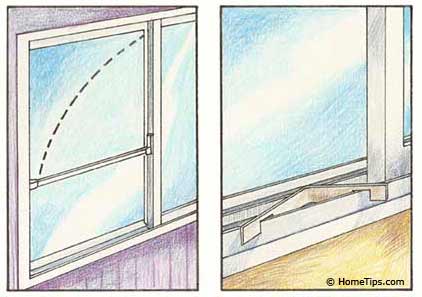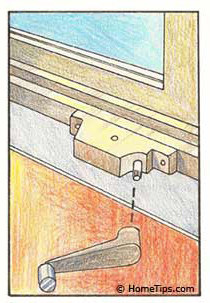Sliding Windows & Doors
Casement Windows
Double-hung Windows
The first step in childproofing windows is to remove or rearrange furniture and other objects that a child might climb to gain access to a window. Of course, if a child has the will to get up to a window, there’s probably a way he or she will figure it out. So, you will have to limit the window’s opening size or create a barrier to prevent your child from falling out.

A Charley bar (left), when down, locks a sliding window shut. A shaped metal clip (right) inserted into the lower track, stops a sliding window from opening completely.
Don’t rely on window screens as a barrier when childproofing windows—a child can lean against a screen and tumble right through. You can block the openings with standard window grilles. Just be sure an adult or older child can release the barrier from the inside in an emergency.
Windows and doors that reach within 18 inches of the floor should be glazed with safety glass. Because even dealers and contractors are not always fully familiar with safety glass particulars, let your local building inspector guide you.
To keep people and pets (as well as birds) from walking through or slamming into tall windows and sliding glass doors, stick a few colorful decals on them or place furniture in front of them.
Several different kinds of locks are available for both childproofing windows and doors.
Sliding Windows & Doors
Sliders can be protected in several ways. You can buy a keyed lock that fastens onto the track or a shaped metal strip that clips onto the track. Bolt-action slider locks allow a door to be opened for ventilation. Again, if you use a keyed lock, hang the key nearby where an adult can reach it in case of emergency.
A “Charley bar” (shown above) is easy to mount and, when in its down position, wedges a slider shut. It can be raised and clipped to the wall or frame when you want to use the window or door.

Removing the crank of a casement window makes it inoperable. Store the crank nearby but out of a small child’s reach.
Casement Windows
Any window with a crank is easy to childproof just by removing the crank and storing it out of a child’s reach. Alternatively, you can install a door-type safety chain.
Last but not least, don’t forget the potential dangers associated with window coverings. To guard against the possibility of strangulation, cut off shade, blind, and curtain cords to their shortest possible lengths and eliminate any loops at the ends. If the window covering requires a long cord, screw a tie-down fixture to the wall near the top of the window and wrap the cord around it.
Double-hung Windows
These types of windows can be locked shut with an ordinary sash lock, which is usually too difficult for a child to turn. For more security, install keyed sash locks and hang the key on a screw next to the window, well above a small child’s reach but where adults and older children can easily access it in an emergency.
For a double-hung window not needed as a fire escape, you can cut a thin block of scrap wood and nail it inside the upper track as a stop for the lower window section. Another method is to screw the lower section to the frame and use the upper section for ventilation.
Get a Pre-Screened Local Home Childproofing Pro
